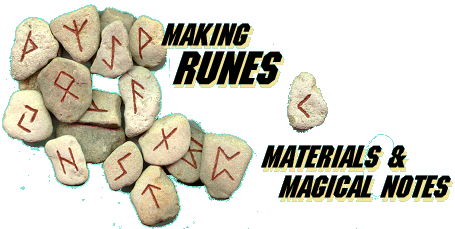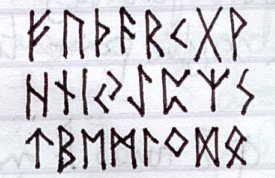

 |
||
 |
||
|
|

I've long held that the systems are all as good as one another; some work better for one person than another, but none is intrinsically better or more accurate than any other. It may be true that, as these systems are quite tightly integrated into their cultures, it is easier for someone to work with their native system than with a foreign one - but that certainly doesn't deny the validity of other systems. The African rune vitki and the suburban Japanese mambo aren't paradoxes. To date, I have used both the Tree of Life and the Tarot, but recently I was bugged by the complexity of both of these systems. Ritual around them is complicated, and while that used to appeal, it doesn't any more. And divination too is rule-bound. The rune system appeared to me to be intrinsically simpler and more intuitive. That, plus a couple of synchronicitous nudges, motivated me to make a set of runes. A word on divination is probably not out of place. It could be argued that all the possible pasts and futures are spread around us, linked by time and a myriad of probabilities. Some of these probabilities are clear: step out in front of that car and get hit. Some are more subtle, and have knock-on effects that can last for years. And of course, they interact, so that pretty soon you don't just have a "decision tree" but a shifting sea of possibility. Divination is a way to tap into that sea of possibility. Maybe it's in your head, maybe not; the point is that it works and is useful.
My set of runes were to be used primarily for divination, so I wanted something robust and lasting. Runes have traditionally been made from a variety of materials; many modern sets are made from wood. But runes, to me, have always been linked to stone, and so I decided to make my set from stones. What sort of stone? There are many choices. But I didn't want to deliberate over the associations of one type of stone over another; that's the kind of rules-work that I was trying to get past. I wanted something plain and honest, straightforward. In the end I chose stones from the gravel bed that sits at the front of my house. "Why?" I was asked, "That's hardly magical." I beg to differ. The stones aren't remarkable, true - they haven't been harvested from wind-blasted crags at great risk to life and limb. And they aren't some special stone either. Just gravel, mostly limestone and quartz, blasted from a quarry somewhere in the country. But their very mundanity seemed important. They're home-stones. I have a link to them already, and that seemed to be more important than an exotic or obscure origin. As soon as I had started to consider using these stones, the other options closed themselves off - which is always a pretty clear sign.
Which rune script to use? The choice here was pretty simple. The Elder Futhark is the oldest, simplest, and has the most work written about it. The Younger Futhark seemed complicated, and the cultural appeal of the Anglo-Saxon Futhark was dimmed by its complexity and relative obscurity. So the Elder it was. Now, I'm fussy. To me, many depictions of the runes have the proportions all wrong; there is no homogeneity of form. A rune set drawn by the same hand should, like handwriting, carry some consistency across the forms. Several evenings were spent trying-out various forms before I settled on the ones shown here.

Why these? Well, for a start they hang together well (to my eye) to form a clean-looking alphabet. Scripts in this set look like scripts and not just haphazard masses of symbols. By holding to a consistent form, when you construct a bindrune one set of forms will allow others to appear, without clashes of angle. I identified several basic forms and decided on a rule for each which I then applied to all the rune-staves in that form-family. You might like them, you might not (I know one person who will disagree with my form for othel), but they work for me. The next decision was regarding the blank rune, Wyrd. It's a fairly recent innovation but that doesn't make it any less valid; it works well for some people. But to me the twenty-four Elder runes sit together "just so" and don't need the extra rune. Of course I may change my mind as I use the runes more, in which case I'll take a pebble from my gravel-bed and add it to the set. But for now at least, I'll skip the blank rune.
In order to make these runes, I needed some way of carving the stone and some way of marking the grooves to make them more visible. There were several options for carving. I could use miniature chisels, or files, or I could take the easy route and us a rotary drill with an engraving bit. After considering the other options, I decided to use the rotary drill. I don't have any skill with chisels and don't own any either; I didn't think files would give a suitably sharp edge; and circumstances suggested that the drill set I had lurking in the toolbox was the way to go. I used several large stones to test out the cutting bits, and settled on the one illustrated as giving the cleanest, deepest cut. All the cuts were 1-2mm deep and about 2mm wide. From experiments, it seems best to hold the drill freehand (like a bucking, leaping pen) and clamp the stone in a small table-top vice. Glue strips of modelling plastic or rubber to the jaws of the vice so they don't mark the stones, and reposition the stone often as you work. As it happened, some of the stones I chose had a lot of quartz in them, which is harder than limestone, and I blunted three steel drill bits making all twenty-four runestones. Diamond bits might last longer. How about pigments? I wanted to use as natural a pigment as possible, and my thoughts were towards either a carbon black or ochre red. A little research suggested that red was the more traditional colour to use. A pot of red iron ochre powder was obtained from an art shop. The binder to go with that pigment was a poser. I definitely did not want to varnish the stones for aesthetic and magical reasons, so I needed a robust paint. As a historical re-enactor, I had come across a method for making bone dice in which the spots were marked with a mixture of carbon black and beexwax, so I tried that. No way. The mixture was too stiff, hard to apply accurately, and fell out of the carving. I tried softening it with a little oil, or applying it molten... but it just didn't work. After a quick chat with an artist friend and a scan through a medieval text on artistic processes, I spotted that egg was often used as a paint medium. Egg is a bugger to remove once it has dried, so it seemed to be worth a go. Egg whites gave a runny, bitty paint, but egg yolk gave a thick, glossy, perfect paint. So iron ochre powder in egg yolk it was. Given the size of the carvings, I ended up using a 000-size artists' brush. If you have trouble finding one this small, try your local Games Workshop; they are commonly used for detail painting on wargames miniatures.
As I have already said, I am not into complicated, formal ritual. I used to be; but now I'm in a more intuitive frame of mind. With this in mind, the ritual element to the manufacturing process was quite simple; you might not even call it ritual at all:
I use two very mainstream ways of consulting the runes; the three-norn reading, and a single-rune snapshot. The three-norn reading refers to the three norns, Viking Fates. One draws three stones at random: one represents the past, one the present and one the future. The way they relate, as well as the individual runes, is relevant, but here is not the place to go into a how-to on a subject I'm pretty new to myself. The single-draw snapshot is straightforward; pull one stone. It can be harder to interpret becuase context is all-important. One method I find useful is to have a dialogue while divining. So I may ask, "What will happen to my job?" and get a reading. Based on that reading, I may go on to ask, "Okay, what if I push for a raise?" and get another. Then perhaps, "Okay, forget the raise, what if I'm meek and good?" and another reading. This builds a picture that I find much more accurate and meaningful than a single reading. It's especially good with relationships. Something I have been experimenting with recently is a more formal use. Clear a space to work in, find a reasonably open trance state, and use wormwood as incense to open further. This is astonishingly potent, especially combining the wormwood with some basic seidr techniques, but not something to do every time.
|
||||||||||||||||||||
  
|